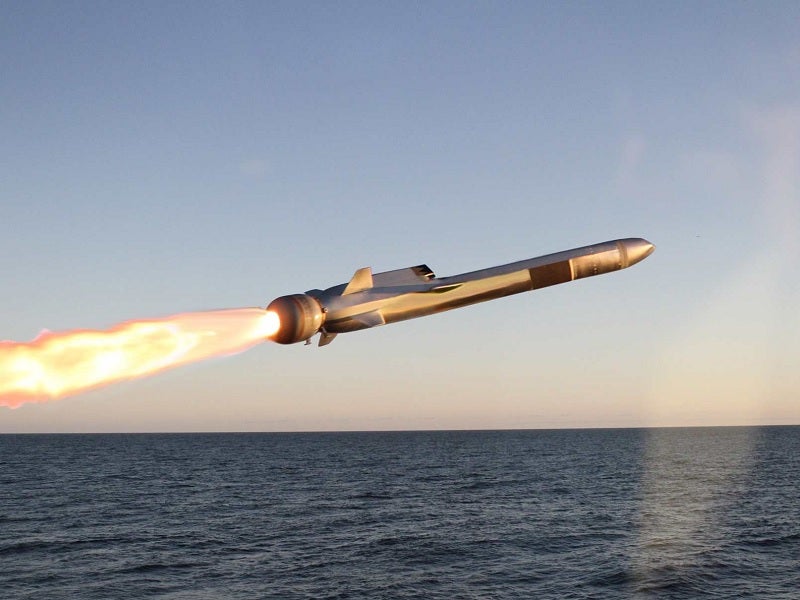
The UK has ended debate, for the time being at least, as to the waning lethality of its surface warships with the announcement that it will acquire the Naval Strike Missile (NSM) from Norway to replace the ageing Harpoon weapon system, which is due to be removed from service next year.
Revealed on 23 November, the move puts to bed years of debate about how and when to replace the Harpoon system in the Royal Navy. The decades-old Harpoon system has been upgraded to the current Block 1C in UK service, although numbers are low with only selected warships able to field them, dependent on tasking and expected security situation in their area of operations.
The UK Government announcement on the selection of the NSM stated that the missile will be outfitted on a total of 11 Type 23 frigates and Type 45 destroyers. Despite the drawdown of the Type 23 frigate fleet as the builds of the Type 26 and Type 31 continue, the 11 warships would still represent less than two-thirds of the UK escort force, indicating that coming vessels could remain unequipped.
Breaking the number down, it is likely that the 11 warships will comprise the entire six-ship fleet of Type 45 destroyers and five of the remaining Type 23 frigates, of which 12 remain in service, split between the general purpose and anti-submarine warfare variants.
Installation timeline
According to the UK Government, an initial batch of three vessels will be fitted with the NSM “at pace” and will be ready for operations from a Royal Navy vessel “in a little over 12 months”.
Further, the missile system will be integrated in UK dockyards operated by BAE Systems and Babcock, with the two companies also primes on the Type 26 and Type 31 frigate builds respectively. However, the Type 26 will be equipped with the Mark 41 vertical launch system (VLS), negating the need for the canister-fired NSM, potentially operating a marinised surface-attack version of the Tomahawk cruise missile.
The Type 31 frigate meanwhile is expected to be extremely lightly armed, with only a small eight-cell anti-air warfare missile system, in additional main and secondary gun systems. Space has been set aside for the possible future integration of the Mark 41 VLS. However, a solution incorporating the NSM onto the Type 31 could offer a relatively cheap way to augment the Type 31’s minimal anti-ship capability.
At nearly four metres in length, the NSM is described as a fifth-generation missile that uses integrated sensors and autonomous target recognition to strike enemy ships and targets on land at distances of more than 100 nautical miles (115 miles) at high subsonic speeds. It can elude enemy radar and defence systems by flying at sea-skimming altitude and using evasive manoeuvres.
The NSM is operated by a range of international customers, including Norway, the US, Poland, Germany, and Canada. In addition, both the US and Australia will operate NSM in the Pacific region.
Norwegian Minister of Defence Bjørn Arild Gram, described the deal as a “significant task” with an “ambitious” timeline.
Interim surface-to-surface guided weapon
The UK’s (interim) surface-to-surface guided weapon ((i)SSGW) programme, through which the delivery of a Harpoon-replacement missile was intended to be delivered, would see a class of missile introduced to offer a temporary anti-ship capability to the UK’s surface escort fleet until the introduction of the Anglo-French Future Cruise/Anti-Ship Weapon project, also known as FC/ASW. The FC/ASW will be launched vertically, and likely integrated into the Type 26 frigate in the 2030s.
With the FCASW programme potential on course to deliver a viable weapon system in the early-2030s, the NSM will likely see service for around a decade with the Type 23 and Type 45 platforms. The last of the Type 23 frigates is due to leave service in 2035, and it could be that the NSM will continue until the class leaves service.
With initial budgets set at around £200m for the (i)SSGW, such expenditure comes on the back of a significant series of announcements by the UK Ministry of Defence in recent days, following the confirmation of the contract award for the second batch of five Type 26 frigates, and preferred bidder status given to Team Resolute, featuring Spanish shipbuilder Navantia and the UK’s Harland and Wolff, in the long-awaited Future Solid Support programme.
Vibrant global missile market
According to the latest analysis from GlobalData, the global missile and missile defence systems (MMDS) market is expected to grow at a compound annual growth rate (CAGR) of 3.5% from 2022-2032, to reach a value of $49.2bn, up from $34.9bn at present.
The missiles segment is expected account for the largest share of 53.1% out of the two primary segments in the global MMDS market from 2022 to 2032. The missile segment was valued at $18.3bn in 2022 and is expected to reach $26.1bn by 2032, growing at a CAGR of 3.7% over the forecast period.


